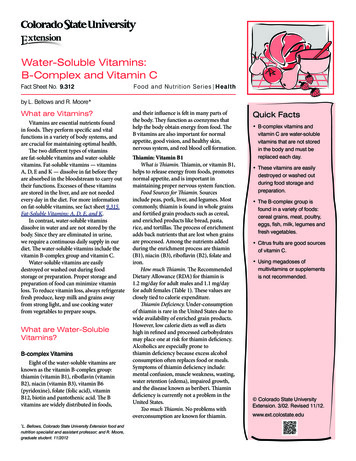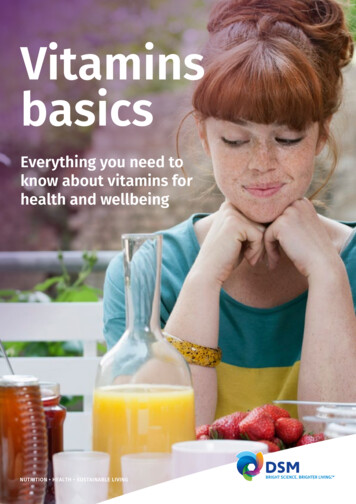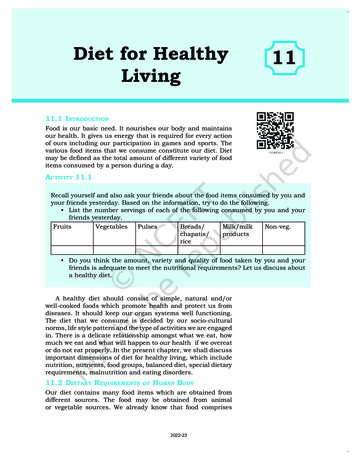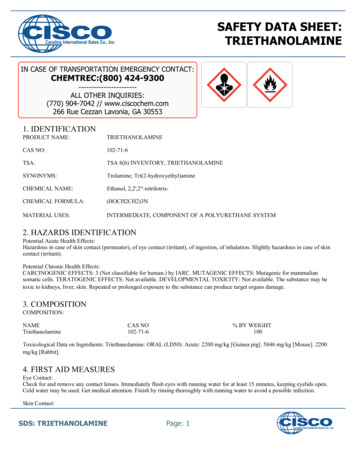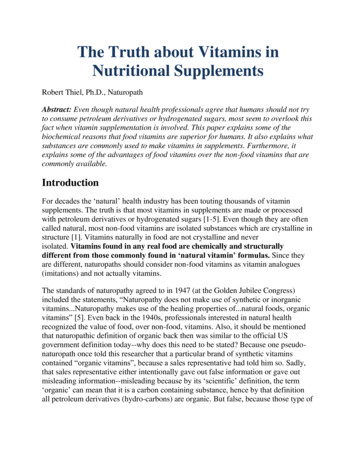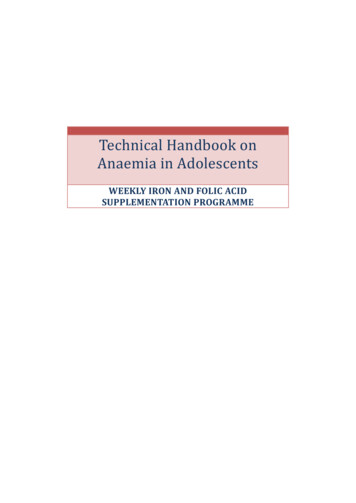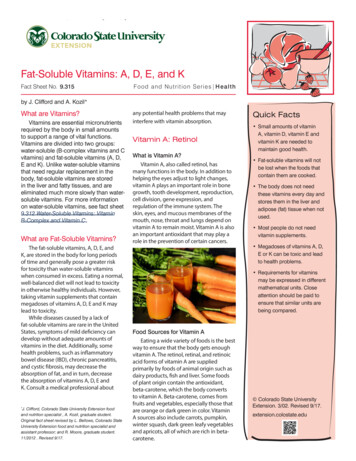
Transcription
Fat-Soluble Vitamins: A, D, E, and KFact Sheet No. 9.315Food and Nutrition Series Healthby J. Clifford and A. Kozil*What are Vitamins?Vitamins are essential micronutrientsrequired by the body in small amountsto support a range of vital functions.Vitamins are divided into two groups:water-soluble (B-complex vitamins and Cvitamins) and fat-soluble vitamins (A, D,E and K). Unlike water-soluble vitaminsthat need regular replacement in thebody, fat-soluble vitamins are storedin the liver and fatty tissues, and areeliminated much more slowly than watersoluble vitamins. For more informationon water-soluble vitamins, see fact sheet9.312 Water-Soluble Vitamins: VitaminB-Complex and Vitamin C.What are Fat-Soluble Vitamins?The fat-soluble vitamins, A, D, E, andK, are stored in the body for long periodsof time and generally pose a greater riskfor toxicity than water-soluble vitaminswhen consumed in excess. Eating a normal,well-balanced diet will not lead to toxicityin otherwise healthy individuals. However,taking vitamin supplements that containmegadoses of vitamins A, D, E and K maylead to toxicity.While diseases caused by a lack offat-soluble vitamins are rare in the UnitedStates, symptoms of mild deficiency candevelop without adequate amounts ofvitamins in the diet. Additionally, somehealth problems, such as inflammatorybowel disease (IBD), chronic pancreatitis,and cystic fibrosis, may decrease theabsorption of fat, and in turn, decreasethe absorption of vitamins A, D, E andK. Consult a medical professional aboutJ. Clifford, Colorado State University Extension foodand nutrition specialist , A. Kozil, graduate student.Original fact sheet revised by L. Bellows, Colorado StateUniversity Extension food and nutrition specialist andassistant professor; and R. Moore, graduate student.11/2012 . Revised 9/17.*any potential health problems that mayinterfere with vitamin absorption.Vitamin A: RetinolWhat is Vitamin A?Vitamin A, also called retinol, hasmany functions in the body. In addition tohelping the eyes adjust to light changes,vitamin A plays an important role in bonegrowth, tooth development, reproduction,cell division, gene expression, andregulation of the immune system. Theskin, eyes, and mucous membranes of themouth, nose, throat and lungs depend onvitamin A to remain moist. Vitamin A is alsoan important antioxidant that may play arole in the prevention of certain cancers.Quick Facts Small amounts of vitaminA, vitamin D, vitamin E andvitamin K are needed tomaintain good health. Fat-soluble vitamins will notbe lost when the foods thatcontain them are cooked. The body does not needthese vitamins every day andstores them in the liver andadipose (fat) tissue when notused. Most people do not needvitamin supplements. Megadoses of vitamins A, D,E or K can be toxic and leadto health problems. Requirements for vitaminsmay be expressed in differentmathematical units. Closeattention should be paid toensure that similar units arebeing compared.Food Sources for Vitamin AEating a wide variety of foods is the bestway to ensure that the body gets enoughvitamin A. The retinol, retinal, and retinoicacid forms of vitamin A are suppliedprimarily by foods of animal origin such asdairy products, fish and liver. Some foodsof plant origin contain the antioxidant,beta-carotene, which the body convertsto vitamin A. Beta-carotene, comes fromfruits and vegetables, especially those thatare orange or dark green in color. VitaminA sources also include carrots, pumpkin,winter squash, dark green leafy vegetablesand apricots, all of which are rich in betacarotene. Colorado State UniversityExtension. 3/02. Revised 9/17.extension.colostate.edu
How Much Vitamin A Do We Need?The recommendation for vitamin Aintake is expressed as micrograms (mcg)of retinol activity equivalents (RAE).Retinol activity equivalents account forthe fact that the body converts onlya portion of beta-carotene to retinol.One RAE equals 1 mcg of retinol or 12mcg of beta-carotene (Table 1). TheRecommended Dietary Allowance (RDA)for vitamin A is 900 mcg/ day for adultmales and 700 mcg/day for adult females.Compared to vitamin A containingfoods, it takes twice the amount ofcarotene rich foods to meet the body’svitamin A requirements, so one may needto increase consumption of carotenecontaining plant foods to meet the RDAfor vitamin A.Studies indicate that vitamin Arequirements may be increased due tohyperthyroidism, fever, infection, cold,and exposure to excessive amounts ofsunlight. Those who consume excessalcohol or have renal disease should alsoincrease intake of vitamin A.Vitamin A DeficiencyVitamin A deficiency in the UnitedStates is rare, but the disease thatresults is known as xerophthalmia,which can lead to blindness ifuntreated. It most commonly occursin developing nations usually due tomalnutrition. Since vitamin A is storedin the liver, it may take up to 2 yearsfor signs of deficiency to appear. Nightblindness and very dry, rough skinmay indicate a lack of vitamin A. Othersigns of possible vitamin A deficiencyinclude decreased resistance toinfections, faulty tooth development,and slower bone growth. Vitamin Adeficiency is also a known risk factorfor severe measles. According to theWorld Health Organization (WHO),Vitamin A supplementation cansignificantly reduce mortality rates forchildren with measles who live in areaswith a high prevalence of Vitamin Adeficiency. The effectiveness of vitaminA supplementation to treat measles incountries, such as the United States,where vitamin A intakes are generallyadequate, is uncertain.Too much Vitamin AIn the United States, toxic orexcess levels of vitamin A are moreof a concern than deficiencies. TheTolerable Upper Intake Level (UL) foradults is 3,000 mcg RAE (Table 2). Itwould be difficult to reach this levelconsuming food alone, but somemultivitamin supplements containhigh doses of vitamin A. Retinol isthe form of vitamin A that causes thegreatest concern for toxicity. If you takea multivitamin, check the label to besure the majority of vitamin A providedis in the form of beta-carotene, whichappears to be safe. Some medicationsused to treat acne, psoriasis, and otherskin conditions contain compoundsthat mimic retinol in the body. Muchlike excessive intake of dietary retinol,these medications have been shownto negatively impact bone health andresult in delayed growth in childrenand teens.Symptoms of vitamin A toxicityinclude dry, itchy skin, headache,nausea, and loss of appetite. Signs ofsevere overuse over a short period oftime include dizziness, blurred visionand slowed growth. Vitamin A toxicitycan also cause severe birth defectsand may increase the risk for boneloss and hip fractures.Vitamin DWhat is Vitamin D?Vitamin D plays a critical rolein the body’s use of calcium andphosphorous. It works by increasingthe amount of calcium absorbed fromthe small intestine, helping to form andmaintain bones. Vitamin D benefits thebody by playing a role in immunity andcontrolling cell growth and may protectagainst osteoporosis, high bloodpressure, cancer, and other diseases.Children especially need adequateamounts of vitamin D to developstrong bones and healthy teeth.Food Sources for Vitamin DThe primary food sources of vitaminD are milk and other dairy productsfortified with vitamin D. Vitamin D isalso found in oily fish (e.g., herring,salmon and sardines) as well as incod liver oil. In addition to the vitaminD provided by food, we obtain vitaminD through our skin which producesvitamin D in response to sunlight.How much Vitamin D Do We Need?The Recommended DietaryAllowance (RDA) for vitamin D appearsas micrograms (mcg) of cholecalciferol(vitamin D3) (Table 1). From 12months to age fifty, the RDA is set at15 mcg. Twenty mcg of cholecalciferolequals 800 International Units (IU),which is the recommendation formaintenance of healthy bone foradults over fifty. Table 1 lists additionalrecommendations for various lifestages.Exposure to ultraviolet light isnecessary for the body to produce theactive form of vitamin D. Ten to fifteenminutes of sunlight without sunscreenon the hands, arms and face, twice aweek is sufficient to receive enoughvitamin D. This can easily be obtainedin the time spent riding a bike to workor taking a short walk with arms andlegs exposed. In order to reduce therisk for skin cancer one should applysunscreen with an SPF of 15 or more,if time in the sun exceeds 10 to 15minutes.Vitamin D DeficiencySymptoms of vitamin D deficiencyin growing children include rickets(long, soft bowed legs) and flatteningof the back of the skull. Vitamin Ddeficiency in adults may result inosteomalacia (muscle and boneweakness), and osteoporosis (lossof bone mass). Vitamin D deficiencyhas been associated with increasedrisk of common cancers, autoimmunediseases, hypertension, and infectiousdisease.Research shows that vitaminD insufficiency affects almost 50%of the population worldwide; anestimated 1 billion people. The risingrate of deficiency has been linked toa reduction in outdoor activity andan increase in the use of sunscreenamong children and adults. In addition,
those who live in inner cities, wearclothing that covers most of the skin,or live in northern climates where littlesun is seen in the winter are also proneto vitamin D deficiency. Since mostfoods have very low vitamin D levels(unless they are enriched) a deficiencymay be more likely to develop withoutadequate exposure to sunlight. Addingfortified foods to the diet such as milk,and for adults including a supplement,are effective at ensuring adequatevitamin D intake and preventing lowvitamin D levels. In the absence ofadequate sun exposure, at least 800 to1,000 IU of vitamin D3 may be neededto reach the circulating level requiredto maximize vitamin D’s benefits.Who is at Risk —These populations may require extravitamin D in the form of supplements orfortified foods: Exclusively breast-fed infants: Humanmilk only provides 25 IU of vitamin D perliter. All breast-fed and partially breastfed infants should be given a vitamin Dsupplement of 400 IU/day. Dark Skin: Those with dark pigmentedskin synthesize less vitamin D uponexposure to sunlight compared to thosewith light pigmented skin. Elderly: This population has a reducedability to synthesize vitamin D uponexposure to sunlight, and is alsomore likely to stay indoors and wearsunscreen which blocks vitamin Dsynthesis. Covered and protected skin: Thosethat cover all of their skin with clothingwhile outside, and those that wearsunscreen with an SPF factor of 8, blockmost of the synthesis of vitamin D fromsunlight. Disease: Fat malabsorption syndromes,inflammatory bowel disease (IBD), andobesity are all known to result in adecreased ability to absorb and/or usevitamin D in fat stores.Too much Vitamin DThe Tolerable Upper Intake Level(UL) for vitamin D is set at 100 mcg(4000 IUs) for people 9 years of ageand older (Table 2). High doses ofvitamin D supplements coupled withgrains, nuts (almonds and hazelnuts),seeds (sunflower) and fortified cereals.large amounts of fortified foods maycause accumulations in the liver andproduce signs of poisoning. Signsof vitamin D toxicity include excesscalcium in the blood, slowed mentaland physical growth, decreasedappetite, nausea and vomiting.It is especially important that infantsand young children do not consumeexcess amounts of vitamin D regularly,due to their small body size.Vitamin E: TocopherolWhat is Vitamin E?Vitamin E benefits the bodyby acting as an antioxidant, andprotecting vitamins A and C, redblood cells, and essential fatty acidsfrom destruction. Research fromdecades ago suggested that takingantioxidant supplements, vitaminE in particular, might help preventheart disease and cancer. However,newer findings indicate that peoplewho take antioxidant and vitamin Esupplements are not better protectedagainst heart disease and cancer thannon-supplement users. Many studiesshow a link between regularly eatingan antioxidant rich diet full of fruitsand vegetables, and a lower risk forheart disease, cancer, Alzheimer’sDisease, and several other diseases.Essentially, research indicates that toreceive the full benefits of antioxidantsand phytonutrients in the diet, oneshould consume these compounds inthe form of fruits, vegetables, nuts, andseeds, not as supplements.Food Sources for Vitamin EAbout 60 percent of vitamin E inthe diet comes from vegetable oil(soybean, corn, cottonseed, andsafflower). This also includes productsmade with vegetable oil (margarineand salad dressing). Vitamin E sourcesalso include fruits and vegetables,How much Vitamin E Do We Need?The Recommended DietaryAllowance (RDA) for vitamin E is basedon the most active and usable formcalled alpha-tocopherol (Table 1).Food and supplement labels list alphatocopherol as the unit internationalunits (IU) or micrograms (mcg), notin milligrams (mg). One microgramof alpha-tocopherol equals to 1.5International units (IU). RDA guidelinesstate that males and females overthe age of 14 should receive 15 mcg(22.5 IUs) of alpha-tocopherol per day.Consuming vitamin E in excess ofthe RDA does not result in any addedbenefits.Vitamin E DeficiencyVitamin E deficiency is rare. Casesof vitamin E deficiency usually onlyoccur in premature infants and in thoseunable to absorb fats. Since vegetableoils are good sources of vitamin E,people who excessively reduce theirtotal dietary fat may not get enoughvitamin E.Too much Vitamin EThe Tolerable Upper Intake Level(UL) for vitamin E is shown in Table2. Vitamin E obtained from foodusually does not pose a risk fortoxicity. Supplemental vitamin E is notrecommended due to lack of evidencesupporting any added health benefits.Megadoses of supplemental vitaminE may pose a hazard to people takingblood-thinning medications such asCoumadin (also known as warfarin)and those on statin drugs.Vitamin KWhat is Vitamin K?Vitamin K is naturally producedby the bacteria in the intestines, andplays an essential role in normal bloodclotting, promoting bone health, andhelping to produce proteins for blood,bones, and kidneys.Food Sources for Vitamin KGood food sources of vitamin K aregreen, leafy-vegetables such as turnip
Table 1. Recommended Dietary Intake (RDA) and Adequate Intake (AI) for Fat-Soluble VitaminsLife Stage GroupVitamin A(mcg1/RAE)Vitamin D(mcg2)Vitamin E(mcg a-TE3)Vitamin K(mcg)0 - 6mo400*10*4*2.0*6mo - 12mo500*10*5*2.5*1 - 3y30015630*4 - 8y40015755*9 - 13y600151160*14 - 18y900151575*19 - 30y9001515120*31 - 50y9001515120*51 - 70y9001515120* 70y9002015120*9 - 13y600151160*14 - 18y700151575*19 - 30y700151590*31 - 50y700151590*51 - 70y700151590* 70y700201590*14 - 18y75015157519 - 30y77015159031 - 50y77015159014 - 18y120015197519 - 30y130015199031 - actationAs retinol activity equivalents (RAEs). 1 RAE 1mcg retinol or 12 mcg beta-carotene.1As cholecalciferol (vitamin D3). 10 mcg cholecalciferol 400 IU of Vitamin D.2As alpha-tocopherol equivalents. 1 mg of alpha-tocopherol 1.5 IU of Vitamin E 22IU of d-alpha-tocopherol 33 IU of dl-alpha- tocopherol3At 6 months of age, infants may be introduced to solid foods while remaining on formula or breast milk. There may be some overlap in specificnutrient requirements.4*Indicates an Adequate Intake (AI). All other values are Recommended Dietary Allowance (RDA).
Table 2. Tolerable Upper Intake Levels (UL) for Fat-Soluble VitaminsLife Stage GroupVitamin A(mcg/d)Vitamin D(mcg/d)Vitamin E(mg a-TE)Vitamin K*0 - 6mo60025ND2ND6mo - 12mo60038NDND1 - 3y60063200ND4 - les9 - 13y14 - 18y2800100800ND19 - 70y30001001000ND 70y30001001000NDPregnant and Lactating 182800100800ND19 - 50y30001001000NDAt 6 months of age, infants may be introduced to solid foods while remaining on formula or breast milk. There may be some overlap in specificnutrient requirements.1ND not determinable due to insufficient data2*An UL for vitamin K was not established.greens, spinach, cauliflower, cabbageand broccoli, and certain vegetablesoils including soybean oil, cottonseedoil, canola oil and olive oil. Animalfoods, in general, contain limitedamounts of vitamin K.Summary Fat-soluble vitamins: A, D, E, and K —are stored in the body for long periods oftime, and pose a greater risk for toxicitythan water-soluble vitamins. Fat-solublevitamins are only needed in smallamounts.How Much Vitamin K Do We Need?To help ensure people receivesufficient amounts of vitamin K,an Adequate Intake (AI) has beenestablished for each age group (Table1).Vitamin K DeficiencyWithout sufficient amounts ofvitamin K, hemorrhaging can occur.Vitamin K deficiency may appearin infants or in people who takeanticoagulants, such as Coumadin(warfarin), or antibiotic drugs.Newborn babies lack the intestinalbacteria to produce vitamin K andneed a supplement for the first week.Those on anticoagulant drugs (bloodthinners) may become vitamin Kdeficient, but should not change theirvitamin K intake without consulting aphysician. People taking antibioticsmay lack vitamin K temporarilybecause intestinal bacteria aresometimes killed as a result of longterm use of antibiotics. Also, peoplewith chronic diarrhea may haveproblems absorbing sufficient amountsof vitamin K through the intestineand should consult their physicianto determine if supplementation isnecessary.Too much Vitamin KAlthough no Tolerable Upper IntakeLevel (UL) has been established forvitamin K, excessive amounts cancause the breakdown of red bloodcells and liver damage. People takingblood-thinning drugs or anticoagulantsshould moderate their intake of foodswith vitamin K, because excess vitaminK can alter blood clotting times. Largedoses of vitamin K are not advised. Beta carotene is an important antioxidantthat the body converts to Vitamin A,and it is found in a variety of fruits andvegetables. Inadequate dietary consumptionof vitamin D, along with limited sunexposure, makes vitamin D deficiency agrowing public health concern. Vitamin E benefits the body by acting asan antioxidant, and research indicatesthat it may offer a protective effect ifobtained through a diet rich in fruits andvegetables, as opposed to a supplementor multivitamin. The bacteria in our gut produce vitaminK, and it is also found in green leafyvegetables.
ReferencesBerdanier, C., Berdanier, L., Zempleni,J. (2009). Advanced Nutrition:Macronutrients, Micronutrients, andMetabolism. Boca Raton, FL: CRCPress, Taylor & Francis Group.Duyff, R. (2012). American DieteticAssociation: Complete Food andNutrition Guide. Hoboken, NJ: JohnWiley & Sons, Inc.Gropper, S., Smith, J. (2009).AdvancedNutrition and Human Metabolism.Belmont, CA: Wadsworth, CengageLearning.Holick, M., Chen, T. (2008). Vitamin Ddeficiency: a worldwide problemwith health consequences.American Journal of ClinicalNutrition, 87 (4), 1080-1086.Institute of Medicine (US). (2002).Dietary Reference Intakes forVitamin A, Vitamin K, Arsenic,Boron, Chromium, Copper, Iodine,Iron, Manganese, Molybdenum,Nickel, Silicon, Vanadium, and Zinc.Washington, DC: National AcademyPress.Institute of Medicine (US). (2000).Dietary Reference Intakes forVitamin C, Vitamin E, Selenium,and Carotenoids. Washington, DC:National Academy Press.Institute of Medicine (US) Committeeto Review Dietary ReferenceIntakes for Vitamin D and Calcium;Ross A., Taylor, C., Yaktine, A.,et al., editors. (2011). DietaryReference Intakes for Calciumand Vitamin D. Washington,DC: National Academies Press.Retrieved from: https://www.ncbi.nlm.nih.gov/books/NBK56070/ doi:10.17226/13050.Colorado State University, U.S. Department ofAgriculture and Colorado counties cooperating.CSU Extension programs are available to all withoutdiscrimination. No endorsement of products mentionedis intended nor is criticism implied of products notmentioned.
Vitamins are essential micronutrients required by the body in small amounts to support a range of vital functions. Vitamins are divided into two groups: water-soluble (B-complex vitamins and C vitamins) and fat-soluble vitamins (A, D, E and K). Unlike water-soluble vitamins that need regular replacement in the body, fat-soluble vitamins are stored
